Abstract
Purified human C3a and synthetic COOH-terminal peptides of C3a, i.e., a pentapeptide, Leu-Gly-Leu-Ala-Arg (5R), and an octapeptide, Ala-Ala-Ala-Leu-Gly-Leu-Ala-Arg (8R) induced histamine release from human basophil granulocytes. On a molar basis, 5R was one-tenth and 8R was one-fifth as active as C3a in causing histamine release. It was found that 125I-C3a binds to whole leukocytes, interacting with both mononuclear cells and neutrophils and the binding was inhibited by preincubation of cells with unlabeled C3a, but not by C5a. 5R and 8R also inhibited the binding of 125I-C3a to the cells. However, on a molar basis, 2,000 times more 8R or 6,000 times more 5R is required for 50% inhibition of 125I-C3a binding as compared with native C3a. Autoradiography of cells using 125I-C3a and 125I-C5a showed preferential binding of 125I-C3a to eosinophils and basophils, whereas 125I-C5a binds primarily to neutrophils and eosinophils and to a lesser extent to basophils. The preferential binding of C3a and C5a to different cell types may herald significance related to their physiological functions.
Full text
PDF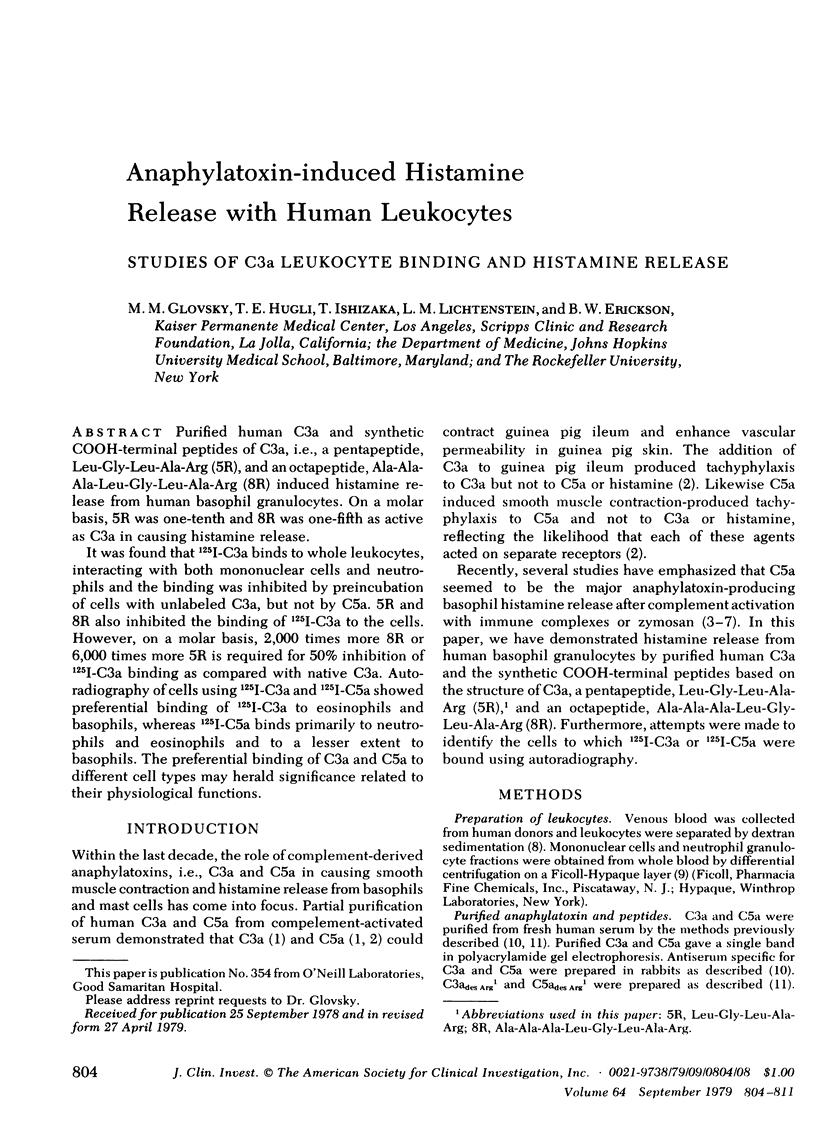
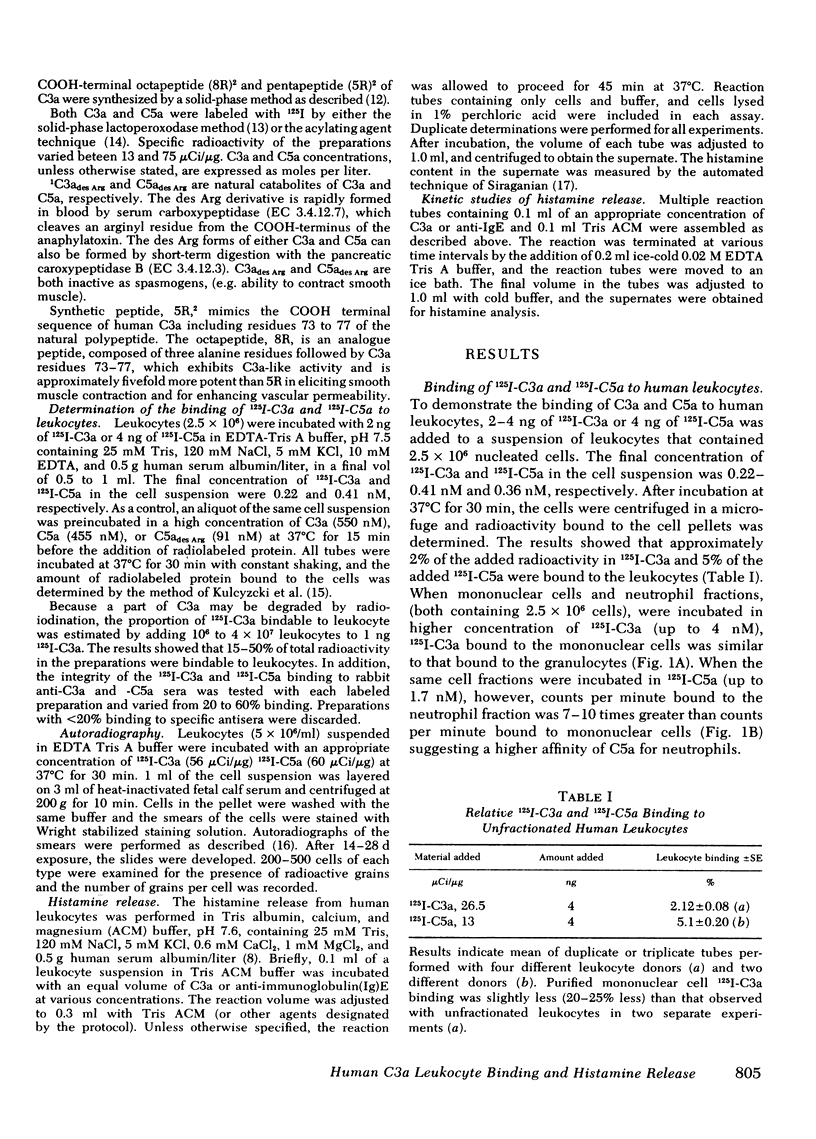


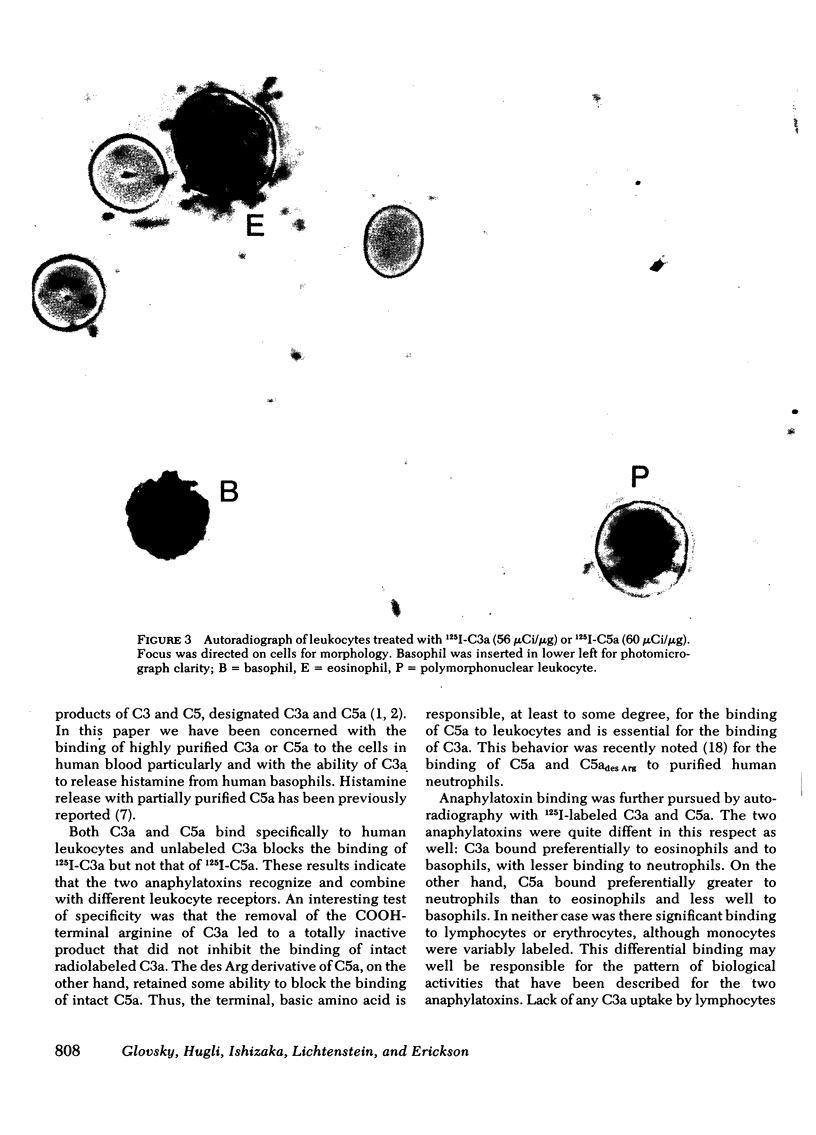
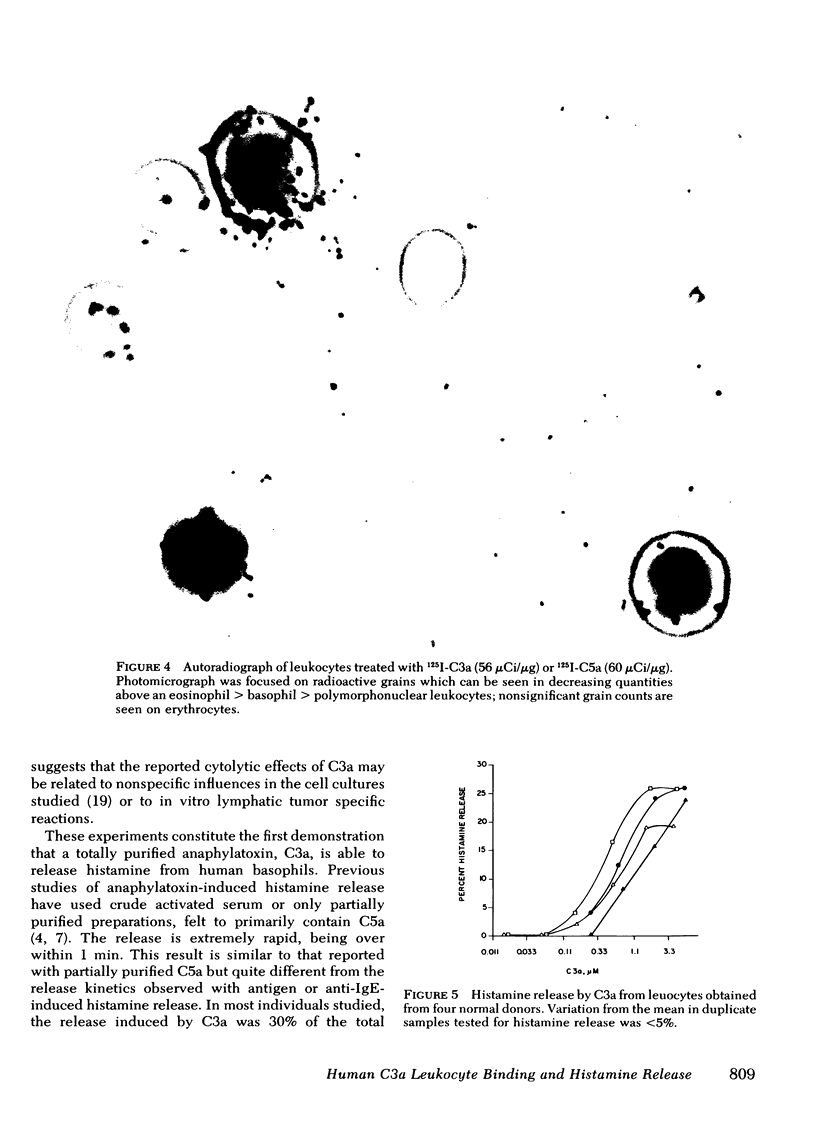
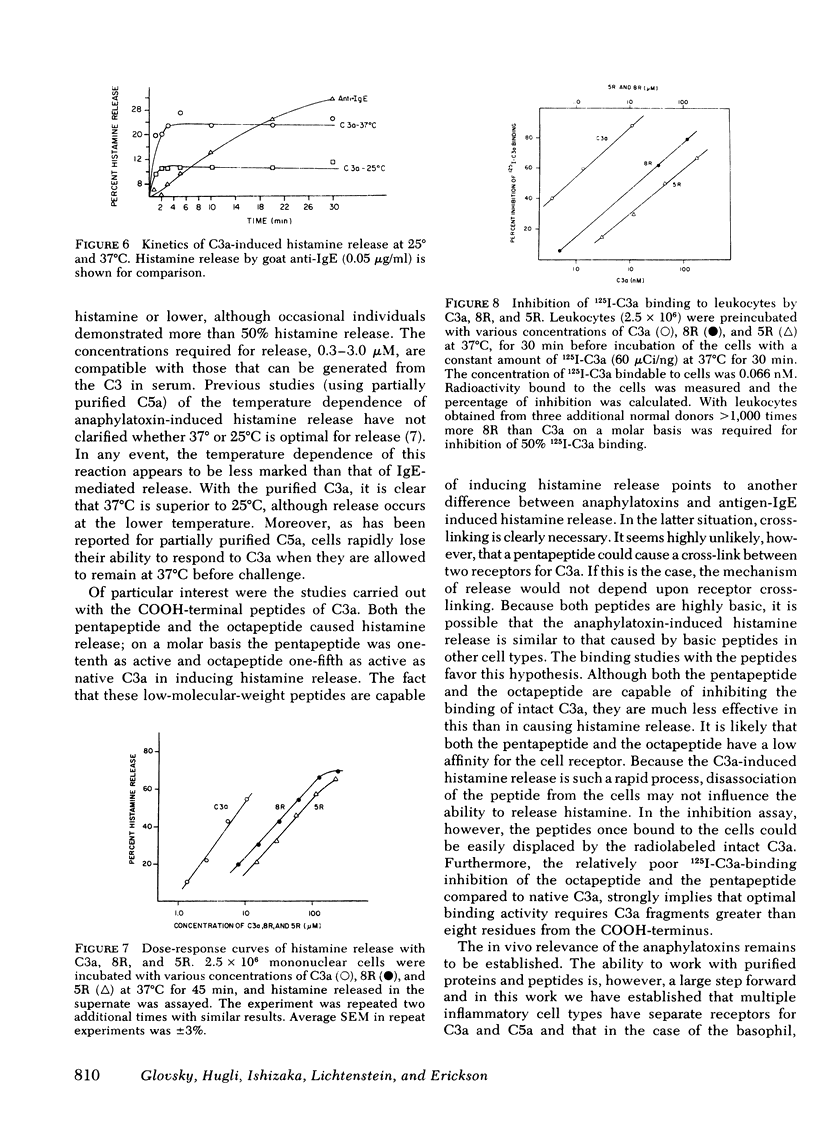

Images in this article
Selected References
These references are in PubMed. This may not be the complete list of references from this article.
- Bolton A. E., Hunter W. M. The labelling of proteins to high specific radioactivities by conjugation to a 125I-containing acylating agent. Biochem J. 1973 Jul;133(3):529–539. doi: 10.1042/bj1330529. [DOI] [PMC free article] [PubMed] [Google Scholar]
- Böyum A. Isolation of mononuclear cells and granulocytes from human blood. Isolation of monuclear cells by one centrifugation, and of granulocytes by combining centrifugation and sedimentation at 1 g. Scand J Clin Lab Invest Suppl. 1968;97:77–89. [PubMed] [Google Scholar]
- Chenoweth D. E., Hugli T. E. Demonstration of specific C5a receptor on intact human polymorphonuclear leukocytes. Proc Natl Acad Sci U S A. 1978 Aug;75(8):3943–3947. doi: 10.1073/pnas.75.8.3943. [DOI] [PMC free article] [PubMed] [Google Scholar]
- Cochrane C. G., Müller-Eberhard H. J. The derivation of two distinct anaphylatoxin activities from the third and fifth components of human complement. J Exp Med. 1968 Feb 1;127(2):371–386. doi: 10.1084/jem.127.2.371. [DOI] [PMC free article] [PubMed] [Google Scholar]
- David G. S., Reisfeld R. A. Protein iodination with solid state lactoperoxidase. Biochemistry. 1974 Feb 26;13(5):1014–1021. doi: 10.1021/bi00702a028. [DOI] [PubMed] [Google Scholar]
- Dias Da Silva W., Lepow I. H. Complement as a mediator of inflammation. II. Biological properties of anaphylatoxin prepared with purified components of human complement. J Exp Med. 1967 May 1;125(5):921–946. doi: 10.1084/jem.125.5.921. [DOI] [PMC free article] [PubMed] [Google Scholar]
- Ferluga J., Schorlemmer H. U., Baptista L. C., Allison A. C. Cytolytic effects of the complement cleavage product, C3a. Br J Cancer. 1976 Dec;34(6):626–634. doi: 10.1038/bjc.1976.223. [DOI] [PMC free article] [PubMed] [Google Scholar]
- Fernandez H. N., Hugli T. E. Partial characterization of human C5a anaphylatoxin. I. Chemical description of the carbohydrate and polypeptide prtions of human C5a. J Immunol. 1976 Nov;117(5 Pt 1):1688–1694. [PubMed] [Google Scholar]
- Grant J. A., Dupree E., Goldman A. S., Schultz D. R., Jackson A. L. Complement-mediated release of histamine from human leukocytes. J Immunol. 1975 Mar;114(3):1101–1106. [PubMed] [Google Scholar]
- Grant J. A., Settle L., Whorton E. B., Dupree E. Complement-mediated release of histamine from human basophils. II. Biochemical characterization of the reaction. J Immunol. 1976 Aug;117(2):450–456. [PubMed] [Google Scholar]
- Hook W. A., Siraganian R. P., Wahl S. M. Complement-induced histamine release from human basophils. I. Generation of activity in human serum. J Immunol. 1975 Apr;114(4):1185–1190. [PubMed] [Google Scholar]
- Hugli T. E., Erickson B. W. Synthetic peptides with the biological activities and specificity of human C3a anaphylatoxin. Proc Natl Acad Sci U S A. 1977 May;74(5):1826–1830. doi: 10.1073/pnas.74.5.1826. [DOI] [PMC free article] [PubMed] [Google Scholar]
- Hugli T. E., Vallota E. H., Müller-Eberhard H. J. Purification and partial characterization of human and porcine C3a anaphylatoxin. J Biol Chem. 1975 Feb 25;250(4):1472–1478. [PubMed] [Google Scholar]
- Ishizaka K., Tomioka H., Ishizaka T. Mechanisms of passive sensitization. I. Presence of IgE and IgG molecules on human leukocytes. J Immunol. 1970 Dec;105(6):1459–1467. [PubMed] [Google Scholar]
- Kulczycki A., Jr, Metzger H. The interaction of IgE with rat basophilic leukemia cells. II. Quantitative aspects of the binding reaction. J Exp Med. 1974 Dec 1;140(6):1676–1695. doi: 10.1084/jem.140.6.1676. [DOI] [PMC free article] [PubMed] [Google Scholar]
- LICHTENSTEIN L. M., OSLER A. G. STUDIES ON THE MECHANISMS OF HYPERSENSITIVITY PHENOMENA. IX. HISTAMINE RELEASE FROM HUMAN LEUKOCYTES BY RAGWEED POLLEN ANTIGEN. J Exp Med. 1964 Oct 1;120:507–530. doi: 10.1084/jem.120.4.507. [DOI] [PMC free article] [PubMed] [Google Scholar]
- Petersson B. A., Nilsson A., Stålenheim G. Induction of histamine release and desensitization in human leukocytes. Effect of anaphylatoxin. J Immunol. 1975 May;114(5):1581–1584. [PubMed] [Google Scholar]
- Siraganian R. P. An automated continuous-flow system for the extraction and fluorometric analysis of histamine. Anal Biochem. 1974 Feb;57(2):383–394. doi: 10.1016/0003-2697(74)90093-1. [DOI] [PubMed] [Google Scholar]
- Siraganian R. P., Hook W. A. Complement-induced histamine release from human basophils. II. Mechanism of the histamine release reaction. J Immunol. 1976 Mar;116(3):639–646. [PubMed] [Google Scholar]




